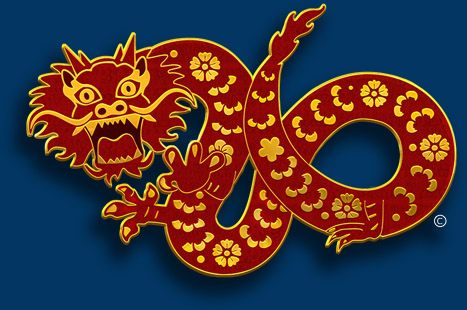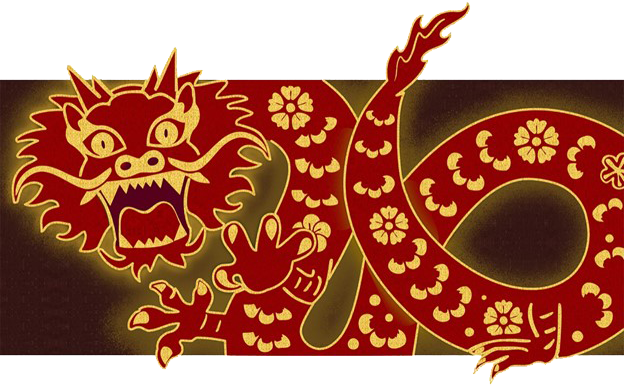Makings Of A Hanshi: Charles Martin
By Christopher Caile
 |
Hanchi Charles Martin, 8th dan, on the floor at World Seido Karate's New York Headquarters in NYC |
The business world of karate is populated by young, instant, self-proclaimed masters, who sport 8th, 9th, even 10th degree black belts and fancy titles as Hanshi, Kyoshi, Grand Master, or Soke. But these people should not be confused with those sincere life-long practitioners who truly represent dedicated spirit and training, men and women who have studied for decades within their respective systems. This article is about a friend and senior from my own karate organization who was just promoted to 8th degree black belt (Hanshi). I have known him for over 30 years. Here is his story.
In June 2008 Charles Martin was one of three senior Seido Karate members who were promoted to Hanshi, 8th dan (degree of back belt). They were the first Seido members ever promoted to this rank by Kaicho Tadashi Nakamura, the founder of Seido Karate headquartered in New York City. Seido Karate is a traditional Japanese style of karate which focuses on karate-do – the development of spirit, character and discipline along with the training of the body, and development of karate skills. The goal of training is realization of each student's human potential.
|
"I am proud of them," said Kaicho to honbu (headquarters) students shortly after the promotion. "All Seido is honored to have such outstanding representatives." At a celebration dinner held a few nights later, Kaicho explained that the word Hanshi means a "great teacher," but most important "a person with a big heart". The three men promoted were Seido's most senior students, those who trained over decades to overcome challenges in both life and training and men who have helped pioneer and promote Seido Karate.
 |
Hanshi Charles Martin assisting Kaicho Tadashi Nakamura in a demonstration held in Madison Square Garden during an event sponsored by the Oriental World of Self Defense in 1977. |
Nidaime Akira Nakamura (Vice Chairman and son of the founder) described their achievements as a "milestone". The night of the dinner was an opportunity for all Seido members to "show them respect that they deserve".
Martin, the most senior Seido student, has been a pillar of Kaicho's karate since 1966. Known for his powerful fighting, he became an international karate champion and East Coast Karate Champion two years running. At various times he also taught Seido karate at five YMCAs in New York and New Jersey. Through the years he assisted Kaicho in many demonstrations, several of which appeared on TV, such as ABC Wide World of Sports, and The Oriental World of Self Defense which recently honored him with membership to its Black Belt Hall of Fame.
If it hadn't been for a stroke of luck, however, Martin might never have practiced karate at all. It was his wife, not Martin, who signed up for martial arts. His wife Ada signed a six month contract for Judo at the Brooklyn Academy of Music, but after two months she became pregnant and dropped out. Not wanting to waste the money, Martin took over her contract and was given a choice of taking judo or karate. He took karate under Tadashi Nakamura who was then serving as North American head of Kyokushinkai Karate.
Kyokushinai at that time was a rough, hard-hitting style of Japanese karate that had been founded by Mas Oyama. As a muscular six foot one inch athlete and former college football player, Martin naturally took to his new martial art. "I started free fighting my very first class, and I loved it," Martin says.
Studying karate was a huge challenge, although he somehow made time for training. Martin was married with two sons. He was working full time at the Port Authority of New York and New Jersey and enrolled in its Management Training Program. At the same time he was finishing college and then graduate school. He later graduated with an MBA from Pace University. For his efforts he was selected as "Black Achiever in Industry" in 1978. When he finally retired in 1995 after 33 years of service, he has risen in his career from an entry-level position to one of senior management.
Those who knew him well were not surprised. Born in 1942 in Huntsville, Alabama, Martin was born at a time of rampant discrimination. He grew up during the early civil rights era and participated in strikes, boycotts and other movements. He went on to attend high school in a military academy in Powhatan, Virginia which instilled in him discipline, loyalty, hard work and persistence. This paid off in both his work and in karate.


U.S. and Japanese posters advertising the 1975 First Open Full Contact World Karate Championship.
In 1975 Martin was selected as one of three US Kyokushinkai fighters to represent the U. S. to compete in the First Open Full Contact World Karate Championships sponsored by Kyokushinkai that year. It was a full contact, knock-out event and a tournament open to any competitor. Attending were the best fighters from 36 countries. They were selected from Kyokushinkai branches around the world, but contestants also included entrants from other karate styles, kung fu and other fighting systems.
Prior to the event Oyama Sensei sent to New York a group of students to visit the Kyokushinkai North American Headquarters then headed by Shihan Tadashi Nakamura. Informally known as the "Seven Samurai," they were top Kyokushinkai instructors who would soon also compete in the upcoming tournament. Their mission was billed as a good-will tour to help promote the upcoming tournament. In actuality it was quite different.
Nakamura Shihan was arguably the strongest of the three Kyokushinkai fighters who traveled to Thailand in the early 1960's to participate in a challenge match against champion Muay Thai fighters (Thai boxing that included low kicks to the legs, elbows and punches to the head). The Kyokunshinkai fighters won, two matches to one.
Nakamura later moved to the US to head the organization's North American Headquarters. He soon developed his own group of strong, tournament-tested fighters. Martin was one. If there was anyone who might truly challenge the Japanese Kyokushinkai fighters, it was from this group. Thus in reality the visit of the "Seven Samurai" to New York City was more to scope out the competition than to promote the upcoming world tournament. In their ten-day visit to the North American Kyokushinkai Headquarters, they watched from the sidelines as New York practitioners worked out and fought. Only once at the end of their stay did they concede to join into practice with their US counterparts. And this practice demonstrated, at least for one Japanese fighter, his own vulnerability.
 |
Charles Martin fighting in the First World Kyokushinkai Tournament held in Japan in 1975. He placed the highest of any foreign competitor. |
During the free-fighting segment of this practice, Charles Martin found himself squared off against Sato Sensei, the largest and strongest of the Japanese contingent and the man who would soon win the First Open Full Contact World Karate Championships. "I knocked him down," said Martin. "He was totally surprised. Reportably this was the first time he was ever knocked off his feet."
This event may help explain how the First Open Full Contact World Karate Championships played out later. The Japanese were allowed more competitors, and foreign fighters were pitted against foreign fighters in eliminations. And if the odds weren't stacked there, on the tournament floor Japanese judges consistently ignored tournament rules in favor of the Japanese competitors.
Later Martin would say, "It was unfortunate that politics and other things outside karate determined the outcome. I never got to face Sato in the tournament even though I had defeated him earlier when we faced off in NYC. He (Sato) never got a chance for the revenge he vowed against me. I guess he will always wonder who would have won if we had fought again."



A comic book cover (left) and two pages from a series of Japanese karate comic books that featured the fighting exploits of Charles Martin and William Oliver. These issues appeared after the First Open Full Contact World Karate Championships sponsored by Kyokushinkai. In the images above (middle and right) a young mustached and bearded Martin is shown in fierce karate combat against several villains.

One of the many different covers sported on video and DVD recordings of the karate documentary "Fighting Black Kings" that followed Charles Martin, William Oliver and others training for, and participating in the final competition of, the First Open Full Contact World Karate Championships.
Despite the tournament politics, however, Martin placed 7th in the world tournament, the highest placement among non-Japanese competitors. In Japan Martin and another US fighter, William Oliver (known for his spectacular kicking combinations), also became minor celebrities. They were featured in a Japanese comic book series, Martin in the images shown above sporting a short afro haircut along with a short beard and mustache. Their exploits in preparing for and competing in the world tournament were also documented in the movie, "Fighting Black Kings." Now on video and DVD, the film remains a minor cult classic.
In 1976 Martin left Kyokushinkai to follow his mentor and teacher Kaicho Nakamura when he formed Seido Karate, a style based on a new philosophy — to extend the benefits of karate and the philosophy of "do" (as in karate-do) to all students. Since that time Martin has been one of Seido Karate's most senior students. He is also not one to rest on his laurels. He still considers himself a student and attends several weekly classes, not only for black belts, but for mixed belt classes too which include basics and drills.
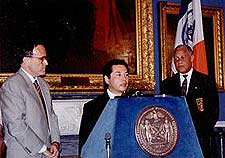 |
Hanshi Charles Martin with Kaicho Tadashi Nakamura during a meeting with New York City Mayor Rudi Guiliani in 1999. For many years Seido Karate has donated funds from benefit karate tournaments through the NYC mayor's office to various charitable causes, such as children and abused women's programs. |
As a senior, Martin often assists Kaicho Nakamura in class, and still fills in and teaches Kaicho's black belt classes when Kaicho is out of town or unavailable. He also assists in officiating for frequent promotions and yearly competitions and has represented Seido in various international visits to member dojos.



Charles Martin breaking roofing tiles during a demonstration in 1990 in Tokyo Japan. Charles Martin was one of several senior students from around the world who assisted Kaicho Tadashi Nakamura in this demonstration to help introduce Seido Karate into Japan.
At the end of class or in meetings Martin often speaks up as an unofficial voice of Kaicho, prompting students toward participation in Seido events, improved respect for seniors, practice of etiquette, etc. As the most senior student after Kaicho Nakamura, Martin is also the first called to speak at meetings and annual events. He is both unassuming and friendly and although outwardly humble, he is really a skilled orator, a man who knows how to cajole the best out of his deep, mellow voice. His comments are often serious, but they are also often spiced by personality – a mix of humor, dry wit and even self-depreciation that can elicit not only laughter, but deep appreciation for what is said.

Hanshi Charles Martin assisting two students in class with a self-defense technique during a recent class.
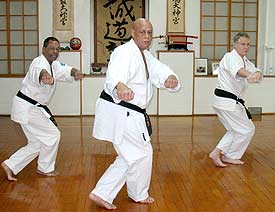
Hanshi Martin often assists senior Seido students with kata and technique before or after class. Here he is assisting Sei Shihan Christopher Caile and Sei Shihan William Best with an advanced kata.
On the dojo floor when teaching, Martin exudes a commanding presence. He extols his students toward serious, realistic practice, while stressing the virtues of hard work and spirited practice. He also has strong opinions.
"You can teach a person the physical aspects of karate," says Martin, "but you shouldn't do that without teaching the mental side at the same time – that is, how to control the use of what's being taught." Despite his expertise and proven fighting ability, Martin is proud of the fact that he has never had to use his karate on the street, and never been in a fight outside the dojo.
 |
Hanshi Charles Martin (left) became well known in Japan for his participation in the 1975 First Open Full Contact World Karate Championships. This notoriety continues today within Seido Karate. He often accompanies Kaicho Tadashi Nakamura during visits to Japan and has often been featured as a senior student with Kaicho Nakamura in magazine covers (this cover from Budo-Ra) and within stories about Seido, its development and its karate technique. At right is Shuzeki Shihan William Oliver (now deceased). |
Although Martin's classes are strenuous and tough, they are greatly appreciated by those who appreciate his practical experience and technique. Because of his background Martin
Stresses realistic technique as well as the benefits of free fighting. If asked, he is also quick to point out that when faced with a real opponent in a fight, it is the person with indomitable spirit who is most likely to come out on top. Thus when teaching he demonstrates what works and shows students how their technique and drills are relevant to self-defense and fighting.
"Too many students come to the dojo to practice and to remember different moves. They practice each move, but do not develop a feeling and understanding of what they are doing." Thus when teaching Martin always stresses the practical application of various Seido exercises and drills. "That way students can understand what they are doing."
"Many students also avoid free fighting practice today," Martin observes. "This is a mistake, for in free fighting you can discover what moves and techniques from your karate training you can apply – what is good for you. You can also develop your own style of fighting. You can perfect your techniques and master them."
If you see him in the dojo when not teaching Martin is friendly and quiet. If asked, however, he is always willing to help other with their technique, explain drills or offer advice. But make no mistake about it: even though his frame has filled out and he is older now, Martin still has an iron will hardened by decades of experience. His afro, beard and mustache have now given way to a clean shaven bald head, but his eyes and thick body still exude spirit and power.
If it weren't for a stroke of luck, however, Seido wouldn't have Martin today. A couple of years ago heading home from class his car was broadsided by a driver trying to speed away from police pursuit. His car was totaled, and Martin missed death or serious injury by only inches.
"I didn't see it coming," Martin says. "I only saw a flash of white." He was lucky. He only suffered wrist and neck injuries, which although nagging, are now largely healed. Despite injuries, however, Martin was soon back in the dojo, although moving a bit slower.
"The accident didn't really hit me until a couple of days later when I saw my grand kids. Suddenly I realized how close I had come to never seeing them again, to losing my family and my life. I think it gave me a greater appreciation for what I had. It is just as Kaicho Nakamura often reminds us: 'that every day should be enjoyed and appreciated. You are in good health and everything seems fine, but you never know. Bang, there is an accident, someone gets sick or is injured. So appreciate this day, appreciate those you are working out with, appreciate your friends and family as if you might never see them again. You just never know.'"
I think this event also had an effect on his karate. He arrives at the dojo, sometimes hours before class and can be seen practicing alone, going over his own kata, weapons and iaido which is included as part of Seido's senior student curriculum. Although the nature of his training had changed, for him training never ends.
How does Martin sum up his philosophy, his essence of "do"? "The good times cause good memories," he says, "while the bad ones become good lessons."
About the Author Christopher Caile
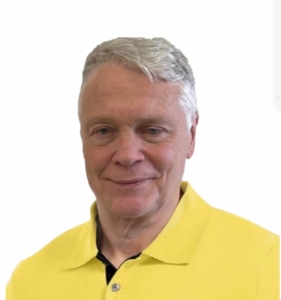
Screenshot
Christopher Caile is the Founder and Editor-In-Chief of FightingArts.com. He has been a student of the martial arts for over 65 years.
He first started in judo while in college. Then he added karate as a student of Phil Koeppel in 1959 studying Kempo and Wado-Ryu karate. He later added Shotokan Karate where he was promoted to brown belt and taught beginner classes. In 1960 while living in Finland, Caile introduced karate to that country and placed fourth in that nation's first national judo tournament.
Wanting to further his karate studies, Caile then hitch hiked from Finland to Japan traveling through Scandinavia, Europe, North Africa, the Middle East and South and Southeast Asia — living on 25 cents a day and often sleeping outside.
Arriving in Japan (1962), Caile was introduced to Mas Oyama and his fledgling full contact Kyokushinkai Karate by Donn Draeger, the famous martial artist and historian. Donn also housed him with several other senior international judo practitioners. Donn became Caile's martial arts mentor, coaching him in judo and introducing him to Shinto Muso-ryu under Takaji Shimizu.
Caile studied at Oyama's honbu dojo and also at Kenji Kurosaki's second Tokyo Kyokushinkai dojo. In his first day in class Oyama asked Caile to teach English to his chief instructor, Tadashi Nakamura. They have been friends ever since. Caile also participated in Oyama's masterwork book, "This Is Karate."
Caile left Japan with his black belt and designation as Branch Chief, the first in the US to have had extensive training in Japan directly under Oyama Sensei. As such, Oyama Sensei asked him to be his representative on visits to his US dojos to report on their status.
A little over a year later, Nakamura, Kusosaki and Akio Fujihira won an epic David vs. Goliath challenge match against Thailand's professional Muay Thai Boxers in Bangkok, Thailand, thrusting Kyolushinkai and Nakamura into national prominence.
Back in the US Caile taught Kyokushinkai karate in Peoria, Il while in college and later in Washington, DC. while in graduate school. Durimg this time Shihan Nakamura had moved to New York City to head Kyokushinkai's North American Operation.
In 1976 when Kaicho Tadashi Nakamura formed the World Seido Karate organization, Caile followed. Living then in Buffalo, NY, Caile taught Seido karate and self-defense at the State University of New York at Buffalo (SUNY Buffalo) for over 15 years where he also frequently lectured on martial arts and Zen in courses on Japanese culture.
Caile moved to New York City in 1999 to marry Jackie Veit. He is now an 8th degree black belt, Hanshi, training in Seido Karate's Westchester, NY Johshin Honzan (Spiritual Center) dojo. In Seido Caile is known for his teaching of and seminars on kata applications. He also produced a 14 segment video series on Pinan kata Bunkai currently available to Seido members.
Caile is also a long-time student and Shihan in Aikido. He studied in Buffalo, under Mike Hawley Shihan, and then under Wadokai Aikido's founder, the late Roy Suenaka (uchi deshi under Morihei Ueshiba, founder of Aikido and was Shihan under Tohei Sensei). In karate, Suenaka (8thdan) was also an in-house student of the Okinawan karate master Hohan Soken.
Having moved to New York City, Caile in 2000 founded this martial arts educational website, FightingArts.com. Twenty-five years later, in 2025, it underwent a major update and revision.
For FightingArts.com and other publications Caile wrote hundreds of articles on karate, martial arts, Japanese art, Chinese Medicine and edited a book on Zen. He also developed relationships with a cross section of leading martial arts teachers. Over the last four decades he has conducted extensive private research into karate and martial arts including private translations of the once secret Okinawan hand copied and passed on Kung Fu book, the Bubishi, as well as an early karate book by the karate master Kenwa Mabuni. He periodically returns to Japan and Okinawa to continue his studies and participate Seido karate events. In Tokyo he practiced (with Roy Suenaka Sensei) in a variety of aikido organizations with their founders – including private interviews and practices at the Aiki-kai Aikido Honbu dojo with the son and grandson of aikido's founder, Doshu (headmaster) Kisshomaru (an old uchi-deshi friend) and his son, Moriteru Ueshiba and in Iwama with Morihiro Saito. On Okinawa he studied Goju Ryu karate under Eiichi Miyazato, 10th dan founder of Naha's Jundokan, and also with Yoshitaka Taira (who later formed his own organization, who specialized in kata Bunkai. While there Caile also trained with Hohan Soken's senior student, Master Fusei Kise, 10 dan as well as with the grandson of the legendary karate master Anko Itosu.
Caile's other martial arts experience includes: Diato-ryu Aikijujitsu and Kenjitsu, kobudo, boxing, Muay Thai, MMA, Kali (empty hand, knife and bolo), study of old Okinawan Shoran-ryu & Tomari body mechanics, study of old Okinawan kata under Richard Kim, study of close quarter defense and combat, including knife and gun defenses, Kyusho Jitsu and several Chinese fighting arts including 8 Star Praying Mantis, Pak Mei (White Eyebrow), and a private family system of Kung Fu.
Caile is also a student of Zen as well as a long-term student of one branch of Traditional Chinese Medicine, Chi Kung (Qigong). As one of two senior disciples of Chi Kung master Dr. Shen (M.D., Ph.D.) Caile was certified to teach and practice. This led to Caile's founding of the The Chi Kung Healing Institute on Grand Island, NY. In Western NY, he also frequently held Chi Kung seminars, including at SUNY Buffalo and at the famous Chautauqua Institution in Chautauqua, NY. His articles on Chi Kung also appeared in the Holistic Health Journal and in several books on alternative medicine.
Caile holds a BA in International Studies from Bradley University and MA in International Relations with a specialty in South and Southeast Asia from American University in Washington, D.C. While in Buffalo, NY he also studied digital and analog electronics.
In his professional life Caile also worked in public relations and as a newspaper reporter and photographer. Earlier he worked in the field of telecommunications including Managing a Buffalo, NY sales and service branch for ITT. He then founded his own private telephone company. This was followed by creation of an electrical engineering company that designed and patented his concept for a new type of low-cost small business telephone system (which was eventually sold to Bell South). The company also did contract work for Kodak and the US space program. Simultaneously Caile designed and manufactured a unique break-apart portable pontoon boat.
Most recently Caile co-founded an internet software company. Its products include software suites with AI capability for control and management of streaming media, such as video and music, an all-in-one book publishing software product for hardcover, eBook and audio book creation and security software for buildings and government use.
For more details about Christopher Caile's martial arts, work experience and life profile, see the About section in the footer of this site.
Search for more articles by this author:
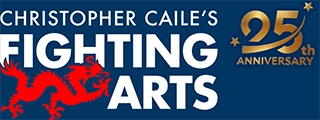
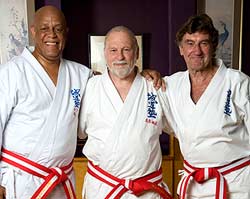 The three newly promoted senior Seido Karate students at the end of their weekend long promotion – Left to right – Hanshi Charles Martin (Honbu, NYC), Hanshi Renzie Hanham (Branch Chief, Christchurch, New Zealand) and Hanshi Andy Barber (Branch Chief, Nelson, New Zealand). A few days later on Wednesday, June 4th, World Seido Karate Organization held a celebration dinner in honor of their promotion to 8th degree black belt. The dinner was held in a restaurant in little Italy in downtown New York City. At the dinner Kaicho Tadashi Nakamura (founder of World Seido Karate) described how far Seido had evolved from its Kyokushinkai beginnings. He noted how Seido kumite has evolved from a sport emphasizing strong fighting with no safety equipment to one focused on safety where students learn the basics of karate and strategies of kumite before they actually start to practice fighting at green belt level. He also addressed Seido's different philosophy. "Now we wear hand and foot protectors, mouth guards and groin cups. In Seido it is also not enough to be just a good fighter, you should also become a good person. We try to develop good character, a strong non-quitting spirit, humility and sense of mutual respect. In this way Seido is a karate for everyone, not just the strong. Our karate helps all students – men, women, the young and even seniors. In this way karate helps you in life, in your job and with relationships. This is also why we have special programs for the handicapped. Everyone benefits."
The three newly promoted senior Seido Karate students at the end of their weekend long promotion – Left to right – Hanshi Charles Martin (Honbu, NYC), Hanshi Renzie Hanham (Branch Chief, Christchurch, New Zealand) and Hanshi Andy Barber (Branch Chief, Nelson, New Zealand). A few days later on Wednesday, June 4th, World Seido Karate Organization held a celebration dinner in honor of their promotion to 8th degree black belt. The dinner was held in a restaurant in little Italy in downtown New York City. At the dinner Kaicho Tadashi Nakamura (founder of World Seido Karate) described how far Seido had evolved from its Kyokushinkai beginnings. He noted how Seido kumite has evolved from a sport emphasizing strong fighting with no safety equipment to one focused on safety where students learn the basics of karate and strategies of kumite before they actually start to practice fighting at green belt level. He also addressed Seido's different philosophy. "Now we wear hand and foot protectors, mouth guards and groin cups. In Seido it is also not enough to be just a good fighter, you should also become a good person. We try to develop good character, a strong non-quitting spirit, humility and sense of mutual respect. In this way Seido is a karate for everyone, not just the strong. Our karate helps all students – men, women, the young and even seniors. In this way karate helps you in life, in your job and with relationships. This is also why we have special programs for the handicapped. Everyone benefits."